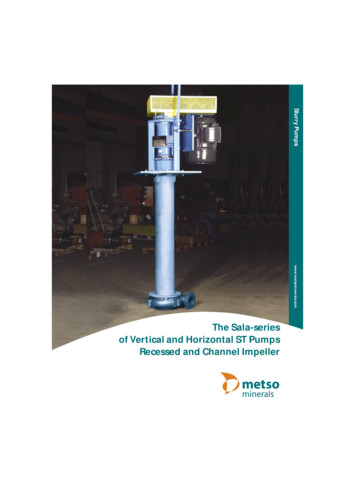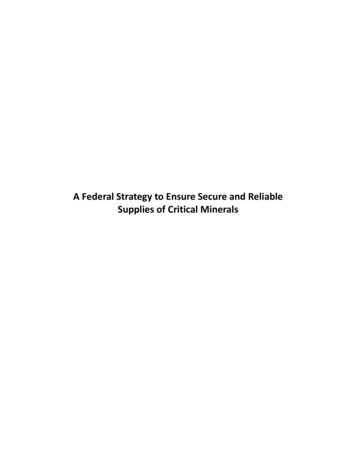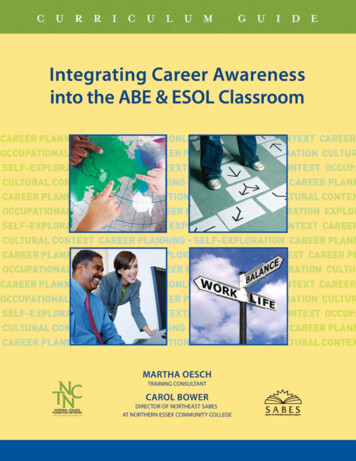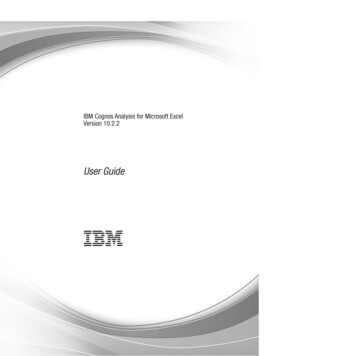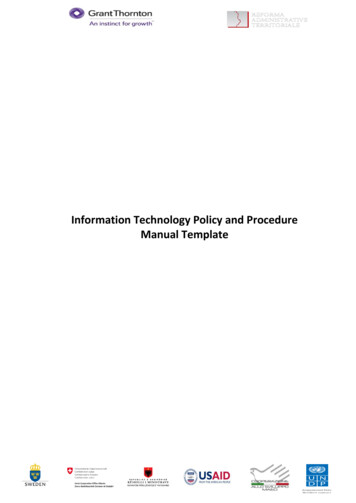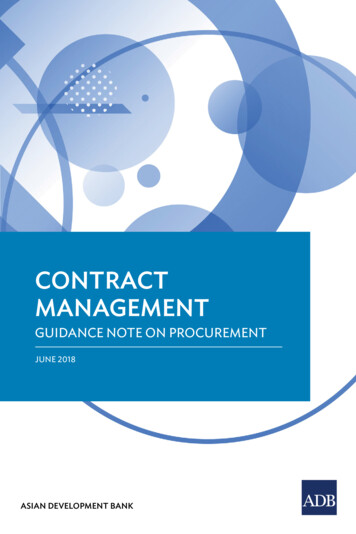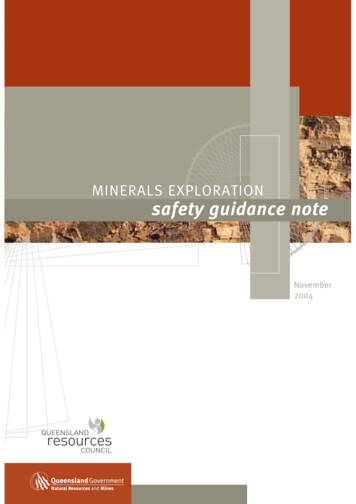
Transcription
MINERALS EXPLORATIONsafety guidance noteNovember2004
MINERALS EXPLORATIONsafety guidance noteNovember2004
Minerals exploration safety guidance noteNovember 2004 The State of Queensland (Departmentof Natural Resources and Mines) 2004#27173 QNRM04092
CONTENTSFOREWORD TO FIRST EDITION (1998)2FOREWORD TO SECOND EDITION3section 1INTRODUCTION4section 2POLICY AND COMMITMENT TO SAFETY AND HEALTH5section 3LEGAL RESPONSIBILITIES7section 4CONTRACTOR RELATIONSHIPS14section 5INDUCTIONS AND TRAINING16section 6PERSONAL CARE AND HYGIENE20section 7MANUAL HANDLING22section 8CAMP MANAGEMENT24section 9FIRST AID28section 10COMMUNICATIONS AND EMERGENCY PROCEDURES29section 11BUSH SENSE AND SURVIVAL32section 12ABANDONED UNDERGROUND WORKINGS ANDOLD MINE SHAFTS35section 13STANDARD WORK INSTRUCTIONS37section 14VEHICLES AND TRAVELLING39section 15TOOLS AND EQUIPMENT43section 16TRACKS, GRID LINES, COSTEANS AND HEAVY EQUIPMENT45section 17EXPLOSIVES, DANGEROUS AND HAZARDOUS GOODS,FLAMMABLE MATERIALS47section 18FIXED WING AIRCRAFT50section 19HELICOPTERS55section 20DRILL SITES AND DRILLING59section 21REFERENCES68section 22CONTACT US70Minerals exploration safety guidance note 1
foreword T O F I R S T E D I T I O N ( 1 9 9 8 )In 1995, the Queensland Resources Council and the then Queensland Department ofMines and Energy established an Exploration Safety Working Group to considermeans of improving exploration safety, including drafting guidelines and increasingpromotion and awareness of safety. The working group consists of explorationmanagers, drilling contractors and representatives of the Department of Mines andEnergy and the Australian Workers Union.The objectives of the guidelines are to assist in reducing accidents, injuries, incidentsand occupational diseases in the exploration industry by ensuring that properattention is given to safety management in all on-shore exploration activities. Theguidelines are not to be interpreted as legislation and have no legislative standing.The Department of Natural Resources and Mines and the Queensland ResourcesCouncil thank all those who have contributed to production of the guidelines, inparticular members of the Exploration Safety Working Group:Roger BillinghamDepartment of Natural Resources and MinesBarry ClarkRockdril Contractors Pty LtdSimon FitzgeraldRockdril Contractors Pty LtdSteve HorsemanBHP Coal ExplorationTim KassulkeNorth LtdNathan MitchellMitchell DrillingDavid MorwoodDepartment of Natural Resources and MinesGraham MuggeridgeCRAEDavid MuntMIM ExplorationRick NelsonCRAEBrian ScholefieldAWUBob SkrzeczynskiBHP MineralsDavid WightmanNorth LtdIan WillisMIM Exploration2 Minerals exploration safety guidance note
foreword T O S E C O N D E D I T I O NSince publication of the Minerals exploration safety guidelines in 1998 and itsreprinting in 2000, changes in Queensland’s mining safety legislation, and populardemand, have resulted in preparation of this second edition.In March 2001, the Mining and Quarrying Safety and Health Act 1999 and the CoalMining Safety and Health Act 1999 came into force. These Acts represented a majorrewrite of the legislation applying to mine safety in Queensland, and introduced theconcepts of obligations to ensure that risks at mines are managed to an acceptablestandard. For the first time exploration for coal in Queensland comes under the samelegislation as the mining and processing of coal.As a result of the new legislation, Section 3 of this publication, Legal responsibilities,was fully revised for this new edition. As the term ‘guideline’ now has a specificmeaning under the Queensland Mining and Quarrying Safety and Health Act 1999,the publication was renamed Minerals exploration safety guidance note.Most of the contents of this edition have remained unchanged, as they wereoriginally written to cover generic situations. However, references have been checkedand updated. Unless otherwise specified, all legislation cited in the publication isQueensland legislation.Demand for this publication has remained high, and it is still considered one of themost useful documents covering safety and health in the Australian mineralsexploration industry.The Department of Natural Resources and Mines thanks all those who contributed tothe revised second edition of the Minerals exploration safety guidance note.Minerals exploration safety guidance note 3
section 1INTRODUCTIONThe Minerals exploration safety guidance note will assist explorers by providing asimple reference or check list of safety issues that should be considered whenplanning fieldwork. It will also assist exploration managers and contractors todevelop their own safety programs for their particular needs. Safety works best whenit is built into all tasks rather than treated as a separate issue.Legal responsibilities for safety and health may be stipulated in various laws, butunless everyone involved in the industry works together willingly to provide andmaintain a safe and healthy working environment, positive improvements are lesslikely to be achieved.While there are several laws covering safety and health in exploration, and eachstate of Australia has its own legislation, there is a similar trend throughout eachstate’s laws. A common law duty of care also exists in each state. The duties andresponsibilities also remain similar, whether exploring for minerals, coal, oil orpetroleum, and whatever exploration techniques are used.The range of activities involved in exploration is vast, and each one may presentdifferent hazards and risks to employees. They vary from flying aeromagnetic surveysto travelling on foot in remote inhospitable country, establishing major campsites,undertaking earthworks, and drilling.Statistics show that most accidents and injuries occur during travelling, manualhandling or drilling, and frequently are caused by slipping and falling. Fatalaccidents in the exploration industry in Australia have involved fixed wing aircraftand helicopter crashes, heatstroke, vehicles overturning, and people being caught byrotating rods on drill rigs. Another fatality involved a hydrofluoric acid spill.The best way to reduce accidents is by employers, in conjunction with employees: ensuring that all employees are competently trained to do their work identifying hazards in the job assessing the risks from the hazards managing the risks.4 Minerals exploration safety guidance note
POLICY AND COMMITMENT TO SAFETY AND HEALTHsection 2Without commitment from all senior executives of organisations such as explorationcompanies, safety and good occupational health in the workplace cannot beachieved. This commitment must then flow through all levels of the organisation.The Queensland Government and the Queensland Mining Council showed theircommitment to safety and health by establishing the tripartite Exploration SafetyWorking Group in 1995 to improve safety in the exploration industry. At its firstmeeting the working group adopted the following Statement of Commitment:The Exploration Safety Working Group is committed to achieving maximum safety in theexploration industry with an ultimate goal of zero lost time incidents. The ExplorationSafety Working Group will foster industry-wide awareness and cooperation in safety todevelop an environment in which all participants can work safely and productively. Thiswill be achieved by industry acceptance of safety standards and procedures asrecommended in guidelines to be produced by the Exploration Safety Working Group.The working group’s commitment was demonstrated by the development of guidancenotes, presentation of awareness seminars, and the publication and dissemination ofsafety information. The group also provides encouragement and assistance toemployers and employees, if needed.To further reinforce the safety and health ethos, exploration companies andcontractors need to promote a company-wide statement from the chief executiveofficer. This statement should send a clear message to all employees, suppliers andcontractors that safety and health are an integral part of the management of alloperations of that organisation.A safety and health policy should: be in writing and be signed and dated by the chief executive clearly state the organisation’s safety and health objectives declare management’s commitment and determination to achieve those objectives be clearly understandable be available to all employees be implemented at all levels be reviewed periodically.Management can show its commitment to safety and health by:Minerals exploration safety guidance note 5
section 2 POLICY AND COMMITMENT TO SAFETY AND HEALTH providing adequate financial and human resources to coversafety and health needs providing adequate training to carry out work safely developing and adopting safety management systems involving all employees in safety issues relevant to their work introducing safety committees and ‘tool box’ meetings empowering employees to take the necessary action to improve safety providing feedback to safety requests reviewing policies and procedures as required.Employees will be committed to a safety and health ethos only if they believe, andare shown, that the company itself is committed. They must be able to see thatimprovements in safety are being made and that policies are implemented in thefield.6 Minerals exploration safety guidance note
L E G A L R E S P O N S I B I L I T I E S section 3The legal responsibilities for safety and health for exploration companies, explorationmanagers, contractors, contractors’ managers and workers vary depending uponwhere in Australia the operations are carried out. Two aspects of responsibilitiesmust always be considered: Compliance with the statutory law of the relevant state, for example, inQueensland the Mining and Quarrying Safety and Health Act 1999. Common law duty of care, which requires an employer to take reasonable care forthe safety of people.Statutory law results from Acts of Parliament. Common law results from precedentsestablished by judges in courts of law.Relevant statutory law relating to occupational health and safety in explorationwork in Queensland includes the: Mining and Quarrying Safety and Health Act 1999 and the Mining and QuarryingSafety and Health Regulation 2001. This law relates to safety and health inmetalliferous mining and quarrying operations, and to mineral exploration otherthan exploration for coal, oil and gas. Coal Mining Safety and Health Act 1999 and the Coal Mining Safety and HealthRegulation 2001. This law relates to safety and health in the coalmining industry,including exploration for coal. Petroleum Act 1923. This law relates to the production of and exploration for oiland gas. The legislation has been completely reviewed and will be replaced by thePetroleum and Gas Production and Safety) Act 2004. This new Act comes intoforce during 2005. Workplace Health and Safety Act 1995 together with its Regulations, Codes andStandards. This legislation covers all occupational health and safety matters inQueensland except where the Mining and Quarrying Safety and Health Act 1999,the Coal Mining Safety and Health Act 1999 and the Petroleum Act 1923 apply.Other laws which may impact on safety and health for specific exploration activitiesinclude the: Explosives Act 1999 (administered by the Department of Natural Resourcesand Mines) Radiation Safety Act 1999 (administered by Queensland Health) Transport Operations (Marine Safety) Act 1994(administered by Queensland Transport) Civil Aviation Act 1988(administered by the Commonwealth Department of Transport) Water Act 2000(administered by the Department of Natural Resources and Mines).Minerals exploration safety guidance note 7
section 3 LEGAL RESPONSIBILITIESMining and Quarrying Safety and Health Act 1999 and Coal MiningSafety and Health Act 1999In Queensland, exploration for minerals other than petroleum and gas is conductedunder the relevant mining safety and health legislation: the Mining and QuarryingSafety and Health Act 1999 and the Coal Mining Safety and Health Act 1999. Thesetwo Acts are almost identical and follow common principles. However, theRegulations for each Act are different, because of the different natures and sizes ofmetalliferous mines and quarries when compared with coalmines. In the definition of‘mine’ and ‘coalmine’, the Acts include exploration activities carried out on miningtenure issued under the Mineral Resources Act 1989.The Acts apply to: everyone who may affect the safety or health of persons at a mine everyone who may affect the safety or health of persons as a resultof operations or coalmining activities any person whose safety and health may be affected while at a mineor as a result of operations or coalmining activities.The objectives of the Acts are to: protect the safety and health of persons at mines and personswho may be affected by mining operations or activities require that the risk of injury or illness to any person resultingfrom mining operations or activities is at an acceptable level.Basic principlesThe principles of the Acts are that risks must be managed at an acceptable level andthat all persons involved in the industries have obligations relating to safety andhealth. The level of obligation is dependent on, to a certain extent, the ability of theperson to have an impact on safety and health. The greater the ability, the greater isthe obligation.The Acts refer to appointment of operators by the mining tenure holder and toappointment by the operator of a site senior executive. The Acts seek to achievecooperation between operators, site senior executives and workers to meet the objectsof the Acts. Cooperation includes involving workers in management of the risk.As well as coalmines, metalliferous mines and quarries that employ 11 or moreworkers are required to have documented safety and health management systems.All persons working at mines must be competent to perform their duties.Competence for a task is the demonstrated skill and knowledge required to carry outthe task to a standard necessary for a person’s safety and health.8 Minerals exploration safety guidance note
section 3 LEGAL RESPONSIBILITIESControl and management of risksThe Queensland legislation requires that the level of risk of injury or illness is: within acceptable limits as low as reasonably achievable.To decide whether risk meets the above requirements, the likelihood of injury orillness from the risk, and the severity of the risk, must be considered.Risk is effectively managed when all persons individually and as part of the workgroup and organisation take action to keep the risk to an acceptable level. Inparticular, this means following risk management procedures and practices that areappropriate for the work being carried out.Risk management is the systematic application of policies, procedures andpractices to: identify, analyse and assess risk avoid or remove unacceptable risk monitor levels of risk and the adverse consequences of retained residual risk investigate and analyse causes of accidents and high potential incidents toprevent their recurrence review effectiveness of risk control measures take appropriate corrective and preventive action.If there is an unacceptable level of risk to persons, they must be evacuated to a safelocation and action must be taken to reduce the risk to an acceptable level.When hazards are identified and risks analysed, the standard hierarchy of hazardcontrols should be adopted, as follows: elimination of the hazard substitution with a lesser hazard separation of persons from the hazard engineering controls administrative controls use of personal protective equipment (PPE).To obtain a greater understanding of risk management, refer to the followingpublications: MDG 1010—Risk management for the mining industry(Department of Mineral Resources, New South Wales) AS/NZS 4360—Risk management(Standards Australia)Minerals exploration safety guidance note 9
section 3 LEGAL RESPONSIBILITIES National minerals industry safety and health risk assessment guidelines(Minerals Council of Australia) Workplace health and safety risk management advisory standard(Division of Workplace Health and Safety, Queensland).Safety and health obligationsThe Queensland legislation places clear obligations on workers and other persons atmines who may affect safety and health. These persons include: holders of tenements issued under the Mineral Resources Act 1989 operators of mines as appointed by holders site senior executives (the most senior person on site) contractors designers, manufacturers, importers and suppliers of plant for use at the mine erectors and installers of plant manufacturers, importers and suppliers of substances for use at a mine suppliers of services.The Acts clearly state the obligations for persons generally and for each of the abovepersons. Some of the obligations of workers and other persons generally are to: comply with the Acts and with procedures applying at the mine share information about risks take any reasonable and necessary course of action to ensure persons are notexposed to an unacceptable level of risk ensure, to the extent of the responsibilities and duties allocated to the worker, thatthe risks of injury to the worker or any other person is at an acceptable level comply with instructions for safety and health work at the mine only if in a fit condition to carry out the work withoutaffecting their own safety and health or that of others.Operators of mines have specific obligations to ensure that: there is an acceptable level of risk to workers at the mine they provide a safe place of work and safe plant they maintain plant in a safe state the operator’s own safety and the safety of others is not affected by the way theoperator works.1 0 Minerals exploration safety guidance note
section 3 LEGAL RESPONSIBILITIESAppointment of operators and site senior executivesThe holder of the mining tenement may appoint an operator for the mine. If anoperator is not appointed, then the holder is also the operator and has all theobligations of an operator.When appointing an operator, the mining tenement holder must give a departmentalinspector of mines for the region written notice of the: name and address of the operator name of and a description of the land comprising the mine.The operator must provide the inspector with a description of the processes to beused, the layout of operations, and information on plant and equipment at the mine(facility description) before operations start. The inspector must also be advised ofthe day on which operations are to start.The operator must also appoint a site senior executive who is the most senior officeremployed by the operator for the mine and who has responsibility for the mine. Thesite senior executive has specific responsibilities, including developing a managementstructure and providing for competent supervision.Obligations of the site senior executive include: ensuring risks from operations are at an acceptable level developing a safety and health management system if 11 ormore workers are employed at a mine training workers so that they are competent inspecting and monitoring the workplace.Mine recordUnder the Acts the operator must keep a mine record, which includes: reports, findings and recommendations resulting from inspections, audits andinvestigations directives issued under the Acts by inspectors, inspection officers and otherpersons allowed to issue directives records of remedial actions taken records and reports about all serious accidents and high potential incidents thathave happened at the mine any reports and information prescribed under the regulations.Minerals exploration safety guidance note 1 1
section 3 LEGAL RESPONSIBILITIESThe Acts do not specify the format of the mine record. It may be kept in the form of ahard-bound book or electronically. Whatever method is used, it must: be kept for seven years be available at all reasonable times for inspection by workers not be destroyed, defaced or altered so that it is no longer a correct andcomplete record.The Mines Inspectorate has produced a Guidance Note—Keeping and using the minerecord at mining and quarrying operations in Queensland.Accident and incident reportingThe Acts have specific requirements for reporting serious accidents and high potentialincidents.General requirements are for: immediate notification to an inspector of mines in the case of:– an accident causing death– an accident causing admission to hospital for a bodily injury endangering or likelyto endanger life– a high potential incident of a type prescribed by regulation monthly reporting of all lost time accidents.If there is a serious accident or high potential incident at a mine, the site seniorexecutive must investigate the accident or incident and prepare a report. The reportmust include recommendations to prevent the accident or incident happening again.To assist operators and site senior executives to understand and comply with reportingrequirements, the Mines Inspectorate has produced guidance notes about reportingserious accidents and high potential incidents. They are: Guidance Note QGN 06—Guidance to metalliferous mines and quarries in reportingserious accidents and high potential incidents to an inspector of mines and adistrict workers’ representative Guidance Note QGN 07—Guidance to coal mines in reporting serious accidents andhigh potential incidents to an inspector of mines and an industry safety and healthrepresentative.1 2 Minerals exploration safety guidance note
section 3 LEGAL RESPONSIBILITIESCommon law duty of careWhile breaches of statutory law are criminal offences heard in a magistrate’s court,common law cases are dealt with in civil courts. The most frequent cases of commonlaw action are those for damages and compensation following a workplace injury.Under common law duty of care the employer has a duty to take reasonable care toensure that employees are not subject to unnecessary risks.In general the employer must provide: a safe place to work a safe system of work proper plant and well-maintained equipment adequate supervision adequate training and instruction.The courts can award compensation if it is shown that the employer is negligent andhas failed to adopt a reasonable standard of care. A reasonable standard of carewould include compliance with statutory law, Australian standards, WorksafeAustralia codes of practice, industry association standards or any other similar codescommonly known in the community.GeneralExploration companies, their managers and safety officers, and those in charge ofexploration programs must make certain that all people employed on a program,including contractors, are fully aware of their responsibilities, duties and obligations.They must ensure that these people are competent and fully trained to do the workfor which they are engaged.It is not sufficient to comply with the law. There must be compliance with relevantstandards and codes of practice.Minerals exploration safety guidance note 1 3
section 4 C O N T R A C T O R R E L A T I O N S H I P SExploration companies often engage contractors at an early stage in any program. It isimportant that the contractor/principal relationship be properly established at this time.In Queensland, when exploration activities are carried out under the mining safetyand health legislation, engagement of a contractor does not relieve the site seniorexecutive of responsibilities for safety and health issues of the contractor’s work. Itis only if the contractor were appointed to be the operator for that work thatresponsibilities and accountabilities can be delegated. In any case, contractors retainobligations under the legislation.Relationships between exploration companies and any contractor must consider thesafety of all employees. Too often, in the past, the principals have tended to ignoreany responsibility for safety of the contractor’s employees and operations.Fortunately, exploration companies are now more aware of their responsibilitiesunder various mining safety laws and common law. They also recognise that poorperformance in safety and environmental matters by their contractors reflects badlyon the exploration company. More importantly, exploration companies realise thatthey can influence the safety performance of contractors.Most exploration tasks that involve the use of uncommon or heavy equipment arecarried out by contracted specialists. Many projects involve a single, site-specificcontract, such as a series of drill holes, bulldozed trenches and tracks, or use of anexcavator. Use of heavy equipment can create new hazards.New hazards can occur when: exploration company employees are working around unfamiliar heavy equipment exploration companies fail to explain all potential hazards at the site the contractor is under pressure for increased production the contractor’s employees are paid production bonuses different safety standards or operating practices exist between the principal andthe contractor.1 4 Minerals exploration safety guidance note
section 4 CONTRACTOR RELATIONSHIPSThese potential problems can be overcome by establishing good cooperativerelationships at an early stage, and by writing tender briefs which include safetyissues. These could include: detailing the laws and safety standards under which the contract will operate providing copies of the principal’s safety manuals and policies to the contractor detailing known hazards in the exploration area requiring the tenderer to include details of their safety policies, manuals andsafety records in their tenders requiring the tenderer to show how compliance with the principal’s standards willbe achieved requiring details of what training will be given by contractors to their employees providing details of training and inductions that will be provided by the principal.The contract itself should include clauses on: compliance with safety laws and standards compliance with the principal’s and the contractor’s policies, procedures andrules concerning health and safety cooperation in the promotion of health and safety awareness safety training, certificates of competency and skills training safety auditing of the contractor’s equipment and work methods by both theprincipal and the contractor, and removal of defective equipment reporting of accidents and incidents to the principal and to the mines inspector conduct of employees of both the principal and the contractor supervision, safety representatives and first aid certificates.Minerals exploration safety guidance note 1 5
section 5 I N D U C T I O N S A N D T R A I N I N GEveryone involved in exploration, including employees, consultants, contractors andvisitors, should undergo formal basic induction training on all relevant aspects ofsafe working practice before starting employment. Induction should be carried outby suitably qualified persons, and on completion should be recorded andacknowledged by the participant in writing.Inductions should be considered in two parts: general induction covering common requirements for all exploration activities specific induction for the particular site and type of exploration beingundertaken.Refresher inductions should be conducted as required and as appropriate.A shorter induction may be more appropriate for visitors.Everyone involved in exploration work should be trained to carry out their work in asafe and competent manner.General basic inductionsSeveral subjects could be included in general inductions and in refresher inductions,depending on the work to be carried out and the location. Possible subjects follow,along with suggested topics for each.Occupational health and safety Relevant company health and safety policy, and safety management systems Relevant standard work procedures Assessment of hazards in the field Use of all types of personal protective equipment (PPE) such as sun protection,sun and safety glasses, and safety footwear Safe use of hand and power tools Safe practices around drill rigs and heavy equipment Housekeeping and basic hygiene while camping The need to carry or have access to potable water Ensuring work plans and destinations are known by others Advising companions of allergies, afflictions, etc. Correct practices for manual handling of equipment Hazards associated with petrol, diesel fuel, liquefied petroleum gas (LPG),other flammables and chemicals Fire prevention, firefighting and bush fires1 6 Minerals exploration safety guidance note
section 5 INDUCTIONS AND TRAINING Company policy on drug and alcohol usage General communications with companions Reporting safety incidents Emergency proceduresFirst aid Explanation of the principles of DRABC(danger, response, airways, breathing, circulation) Treatment of sunburn and other burns Treatment of snake, spider and scorpion bites Stemming bleeding and treating broken bones Dehydration and heat exhaustion Exposure and hypothermia Treatment of shock Contents of various first aid kits, their use and their locationsRadios and communication Need for regular communication between field parties and base Company standard operating procedures Search and rescue procedures Thorough instruction in and demonstration of the use of transceivers, installationof aerials, use of frequencies, selcall (all-purpose ground to air communications),radio telephone and Royal Flying Doctor Service (RFDS) networkMaintenance of equipment Coverage of mobile phone networks and the use of satellite telephonesVehicle/driver awareness and driving techniques Attitudes to road safety, road rules, traffic laws and responsibility towardspassengers and other road users Driving practices for prevailing conditions Driver fatigue, safe drivi
and occupational diseases in the exploration industry by ensuring that proper attention is given to safety management in all on-shore exploration activities. The guidelines are not to be interpreted as legislation and have no legislative standing. The Department of
